The National Gardens Scheme
We have a separate country garden of just over one and a half acres, developed from an old orchard. The garden is listed in the NGS Yellow Book and is open for charity during the summer (from mid May until mid September) daily except Wednesdays from 10.30am to 5.30pm.
The garden is divided into 3 sections, each with its own characteristics. The first is intimate and sheltered with winding paths leading through dense planting. There are shady areas with a feeling of enclosure, where spring flowers give way to jungly perennials and grasses. The second section is more formal. A curved lime lollipop walk leads to two large, parallel borders. There is a feeling of spaciousness and light.The third section, open for the first time this year, is less formal. Large shrubberies with grassed areas offer a number of superb mountain and moorland views.
The garden has featured in the national press and on national television. The highlight occurred when it was shown on BBC2 Gardeners World during August 2009.
Admission is £3.00 for adults and 50p for accompanied children. All proceeds go to charity via the National Gardens Scheme.
The Garden
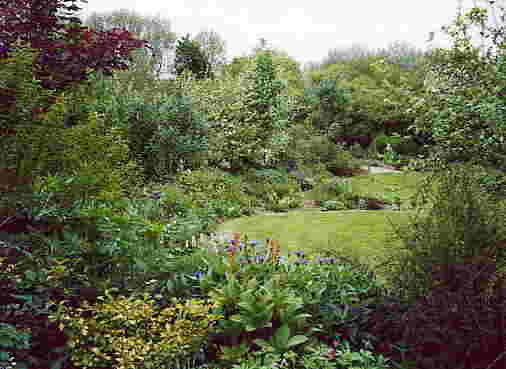 When we moved here 17 years ago we had one seven acre field which was rough grazing land. The whole site was very open and very windy. Our first priority was to plant the thousands of native hedging plants, specimen trees and orchard trees which now provide the backbone to the garden and subdivide the rest of the land. The orchard was not particularly successful due to several reasons: the altitude - 720 feet above sea level, the damp climate - we get in excess of 110 inches (around 3m) of rainfall and our very poor soil, which is only about a spade's depth. We then planted some more ornamental trees. Now, many people comment about the amount of shelter we have here, although these comments are made fine spring and summer days, not on the days where we have gale force winds and horizontal rain that rapidly soaks the legs and fills wellingtons.
When we moved here 17 years ago we had one seven acre field which was rough grazing land. The whole site was very open and very windy. Our first priority was to plant the thousands of native hedging plants, specimen trees and orchard trees which now provide the backbone to the garden and subdivide the rest of the land. The orchard was not particularly successful due to several reasons: the altitude - 720 feet above sea level, the damp climate - we get in excess of 110 inches (around 3m) of rainfall and our very poor soil, which is only about a spade's depth. We then planted some more ornamental trees. Now, many people comment about the amount of shelter we have here, although these comments are made fine spring and summer days, not on the days where we have gale force winds and horizontal rain that rapidly soaks the legs and fills wellingtons.
In the winter of 1999 we decided to create a garden using the current trees as a backbone. During the summer and autumn of 1999 we created the borders. All the herbaceous and shrub planting dates from then. We had our inspection for the National Gardens Scheme in September 1999 and were accepted (with planting still in progress).
 The garden provides a diverse range of growing conditions. It is fairly dry beneath trees and where the hedge roots soak up the moisture from the soil. There are also damp places where springs leach through the soil. There is also a variety of shade, ranging from deep shade beneath mature fruit trees to lightly dappled shade and full sun. Plants that thrive in the appropriate conditions are chosen.
The garden provides a diverse range of growing conditions. It is fairly dry beneath trees and where the hedge roots soak up the moisture from the soil. There are also damp places where springs leach through the soil. There is also a variety of shade, ranging from deep shade beneath mature fruit trees to lightly dappled shade and full sun. Plants that thrive in the appropriate conditions are chosen.
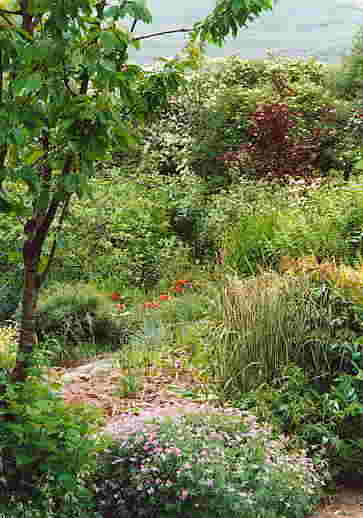 We use this garden to house our plant collection within an attractive garden setting. The garden provides the propagating material for the nursery. It is also used a trial ground for new varieties, in particular for resistance to slugs and snails and also hardiness and suitability for different climatic conditions. Many of our collection of 160 hardy geraniums may be seen growing. The garden is managed in an environmentally friendly manner with organic soil conditioning and a complete ban on slug pellets and chemical pesticides.
We use this garden to house our plant collection within an attractive garden setting. The garden provides the propagating material for the nursery. It is also used a trial ground for new varieties, in particular for resistance to slugs and snails and also hardiness and suitability for different climatic conditions. Many of our collection of 160 hardy geraniums may be seen growing. The garden is managed in an environmentally friendly manner with organic soil conditioning and a complete ban on slug pellets and chemical pesticides.
 The garden comprises of several separate areas each with a different feel. As you enter the garden via the cream wooden gate there is a wide path that meanders down the hill with borders either side. To the right the border is planted with three Betula utilis jacquemontii with attractive pale creamy white bark. These are under planted with white flowered perennials including Pulmonaria, hardy geraniums, astrantia, Shasta daisies, comfrey, tellima and the rare white fruited alpine strawberry. As you progress down the hill the borders are planted with shrubs and mixed perennials.
The garden comprises of several separate areas each with a different feel. As you enter the garden via the cream wooden gate there is a wide path that meanders down the hill with borders either side. To the right the border is planted with three Betula utilis jacquemontii with attractive pale creamy white bark. These are under planted with white flowered perennials including Pulmonaria, hardy geraniums, astrantia, Shasta daisies, comfrey, tellima and the rare white fruited alpine strawberry. As you progress down the hill the borders are planted with shrubs and mixed perennials.
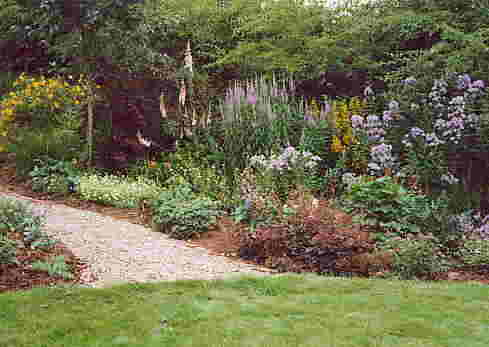 At the bottom of the track turn left into the Cottage Garden which is at its peak from June until mid autumn. During spring 2001 the borders were reshaped to make two circular grass areas surrounded by lush cottage style planting with some evergreen structure shrubs added for winter interest. In 2003 two large circular borders were created.
At the bottom of the track turn left into the Cottage Garden which is at its peak from June until mid autumn. During spring 2001 the borders were reshaped to make two circular grass areas surrounded by lush cottage style planting with some evergreen structure shrubs added for winter interest. In 2003 two large circular borders were created.
 The long borders are currently planted with many of the blue and purple Geranium species and cultivars along with other cottage garden favourites such as Geum, Potentilla, Iris, Sidalcea, Sedum, Dicentra, Nepeta, Campanula and Lychnis. The borders are colour themed with yellows and orange blending into red, magenta and then pruple and blue on one side with pinks blues and white on the other side.
The long borders are currently planted with many of the blue and purple Geranium species and cultivars along with other cottage garden favourites such as Geum, Potentilla, Iris, Sidalcea, Sedum, Dicentra, Nepeta, Campanula and Lychnis. The borders are colour themed with yellows and orange blending into red, magenta and then pruple and blue on one side with pinks blues and white on the other side.
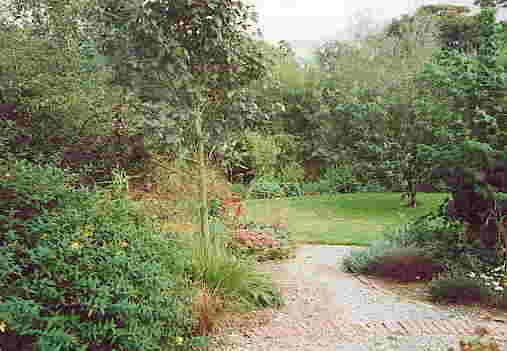 The Cottage Garden leads into the grass garden which is planted with our collection of grasses, sedges and bamboos combined with other plants that compliment the grasses, such as wild flowers and some interesting foliage plants.
The Cottage Garden leads into the grass garden which is planted with our collection of grasses, sedges and bamboos combined with other plants that compliment the grasses, such as wild flowers and some interesting foliage plants.
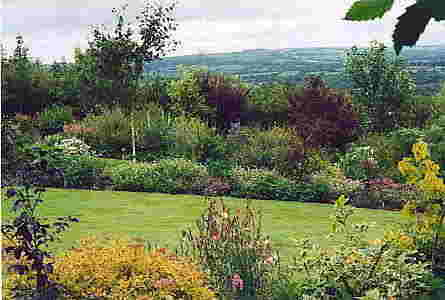 We also grow a range of perennials with daisy type flowers such as Rudbeckia with its black coned, golden daisies, Leucanthemum in several forms and Erigeron (fleabane). There are also plants with grassy leaves such as Crocosmia in several cultivars, Armeria, Sisyrinchium and Hemerocallis.
We also grow a range of perennials with daisy type flowers such as Rudbeckia with its black coned, golden daisies, Leucanthemum in several forms and Erigeron (fleabane). There are also plants with grassy leaves such as Crocosmia in several cultivars, Armeria, Sisyrinchium and Hemerocallis.
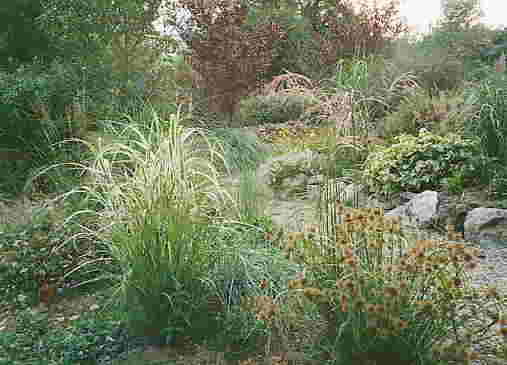 This area peaks late summer and early autumn with the grasses flowering and the fiery shades of Crocosmia in all colours from yellow, apricot though orange to red.
This area peaks late summer and early autumn with the grasses flowering and the fiery shades of Crocosmia in all colours from yellow, apricot though orange to red.
Grass gardens mature quickly. During winter 2000/2001 two long terraced beds were created, cut into the slope. The soil is held back by boulders. The pictures below show the beds before planting in January 2001 and in September 2001.
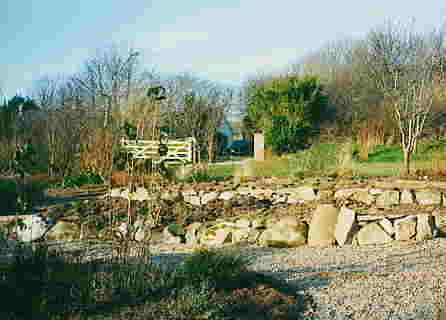
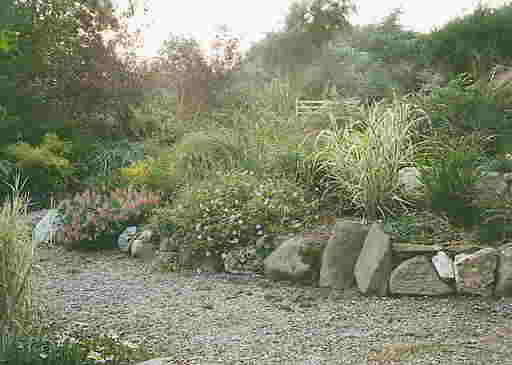
The beds were planted at the end of May 2001 after some varieties had been divided to provide extra plants. The photos below show the same view of the garden in June 2001 and September 2001. All the grasses have matured beautifully and look condiderably older than 3 months.

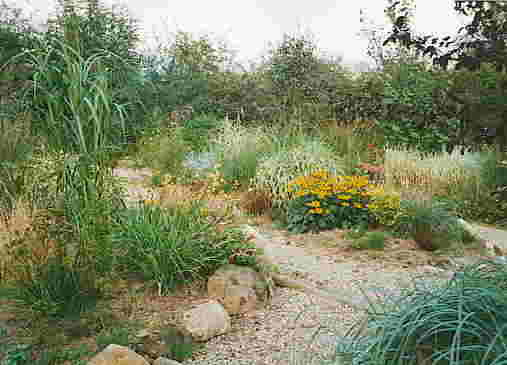
The terraced beds have been planted with many different varieties of grasses of contrasting colour and form. The backbone of the beds is provided by several different Miscanthus and Molinea cultivars where seeing them close together allows the differences and the similarities to be appreciated. Smaller grasses of contrasting form and colour have been planted nearer the edge of the beds along with some red hot pokers. Some of the raised front edges of the terraces have been planted with low growing, mat forming plants to provide a contrast in texture and growth habit. At present we have nowhere for alpine type plants which presently rapidly succumb to the cold wet winters. The borders surrounding the grass garden are used for larger grass specimens, particularly Miscanthus, Calamagrostis and Cortaderia (Pampas) along with some specimen bamboos.

